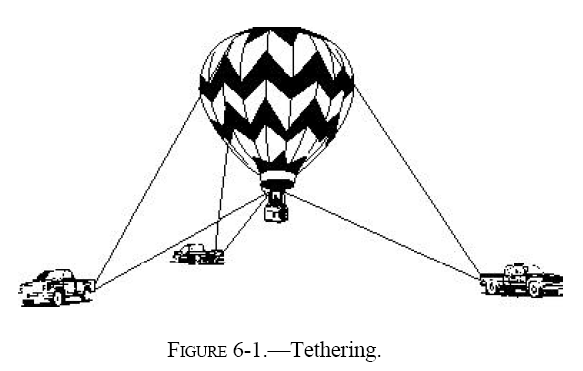|
This chapter discusses tethering and emergency
procedures that are not considered a part of normal
flight operations.
TETHERING
Most balloons are designed to be flown free and not
tied to the ground. However, in almost every
balloonist's life comes an occasion or two when
tethering is desired or required. Contrary to the belief
of many people, it is much harder to tether a balloon
than to fly free.
Considerations
Some important factors to consider before tethering a
balloon are the space available, adequate tie-downs,
airspace, local ordinances, and crowd control. Also,
make sure to check the balloon flight manual for the
recommended tethering procedure.
Space Available
The minimum requirement for safely tethering a
balloon is a space that contains an area clear of
obstacles with a radius twice as wide as the balloon
is tall, plus the intended maximum height. For example,
if the balloon is 70-feet tall, and you intend to fly 50
feet above the ground, the radius of the area needs to
be 190 feet. Then if the balloon was blown down by
wind coming from any direction, the balloon would
not hit an obstacle.
Tie-Downs
Tie the balloon from the top of the envelope, or use a
manufacturer specified tethering harness. To provide
stability, the recommended number of lines, from the
crown (or harness) and from near the burner frame or
basket/envelope interface, should be tied to points
on the ground. Some possible tie-downs are heavy
vehicles (full-size pickups, vans, or utility vehicles).
The best tie-down material is nylon rope; nylon
stretches and is strong. Use a minimum 5/8-inch nylon
three-ply twist. Do not use polyester, braided rope or
webbing because they do not stretch as much and are
not as strong. [Figure 6-1]

Airspace
If you are tethering within Class B, C, or D Airspace,
coordinate operations with ATC. Usually a phone call
will suffice. ATC may ask you to carry a VHF radio
tuned to the tower. Most often a phone call to the
controlling agency, and explaining the nature of your
operation will be sufficient.
Local Ordinances
Sometimes, due to previous operations by
inconsiderate pilots, there may be specific local laws
governing balloon operations in a city or county. Make
sure you are aware of and comply with such
ordinances, or receive a waiver or permission to
operate. Perform your legwork, do your homework,
and do not be surprised by, or surprise, any authority.
Crowd Control
It is necessary to keep people away from the tether
lines and from beneath the basket. It is preferable to
keep spectators outside the area formed by the anchor
points. Be sure to watch that no one interferes with
the anchor points on the ground.
Plan ahead in case there is unexpected wind. Tie down
correctly to strong anchors, use good ropes, ensure
sufficient space, and have adequate crowd control.
Tethering a balloon requires experience and should
always be done with thought and care.
|

